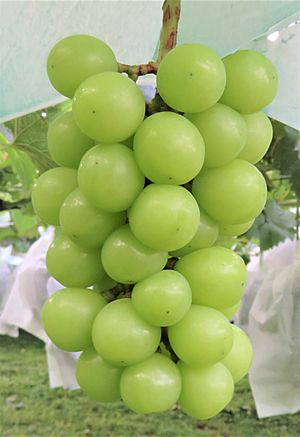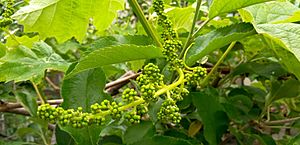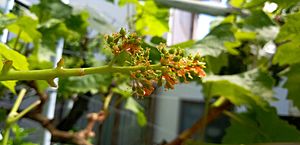Shine Muscat facts for kids
Quick facts for kids Shine Muscat |
|
|---|---|
| Grape (Vitis) | |

Shine Muscat
|
|
| Color of berry skin | Blanc |
| Species | interspecific Vitis hybrid |
| Origin | Japan |
| Original pedigree | Akitsu-21 x Hakunan |
| Pedigree parent 1 | Akitsu-21 = Steuben x Muscat of Alexandria |
| Pedigree parent 2 | Hakunan = Katta Kurgan x Kaiji |
The Shine Muscat is a special type of table grape grown for eating. It was created in Japan in 1988 by crossing two other grape types: Akitsu-21 and Hakunan.
This grape has large, yellow-green berries. Its flesh is crisp, and it has a lovely muscat flavor. It's also very sweet and not too sour.
Contents
How Shine Muscat Grapes Were Created
The Shine Muscat grape was developed in Japan at a special research center. It ripens early, usually in mid-August in the area where it was first grown.
Japanese scientists wanted to create a grape that tasted great but was also easy to grow in Japan's rainy climate. European grapes, like the famous Muscat of Alexandria, taste good but often crack or get sick in wet weather. This means they need to be grown in special glasshouses.
American grapes are tougher and can handle the Japanese climate better. However, they are often harder to chew and sometimes have a unique smell called a "foxy scent," which isn't always popular.
To make a better grape, scientists first crossed an American grape called Steuben (which is very sweet) with the European Muscat of Alexandria. This created a new grape called Akitsu-21. Akitsu-21 had a good texture like Muscat of Alexandria, but its smell was a mix of Muscat and the "foxy scent."
So, the scientists then crossed Akitsu-21 with another large European grape called "Hakunan." Hakunan was known for its good quality and taste. From this cross, the Shine Muscat grape was born, with only the wonderful Muscat aroma.
The best grapes from this cross were chosen in 1988. After many tests across Japan from 1999 to 2002, the grape was officially named "Shine-Muscat" and registered in 2003.
Shine Muscat Family Tree
The Shine Muscat grape has an interesting family tree, showing how different grapes were combined to create it.
- The Akitsu-21 grape came from crossing Steuben and Muscat of Alexandria.
- The Hakunan grape came from crossing Katta Kurgan and Kaiji.
- The Kaiji grape itself came from Flame Tokay and Neomuscat.
So, the Shine Muscat is a mix of all these different grape types!
What Shine Muscat Grapes Look Like
Shine Muscat grapes grow in cylinder-shaped bunches that usually weigh about 400-500 grams. When they are ripe, they are a yellowish-green color. Each grape is short and oval-shaped, weighing about 11 to 12 grams, which is similar in size to a Kyoho grape.
These grapes are very sweet, with about 20% sugar content, and they are not very acidic. A cool thing about them is that if they are treated with a special plant hormone, you can eat the whole grape, skin and all, without any seeds!
The leaves of the Shine Muscat plant are green and have a wavy shape when they are fully grown. The underside of the leaves is covered with tiny, flat hairs.
This grape plant is quite strong. It can handle cold weather, and its color stays good even when the summer is very hot. It tastes, feels, and smells as good as other high-quality European grapes. Plus, it stays fresh for a long time after being picked.
It's also a fast-growing plant. You can get your first harvest just three years after planting it!
How Shine Muscat Grapes Are Grown
In Japan, special methods are used to grow Shine Muscat grapes.
Shaping the Grape Bunches
To grow large grapes and big bunches, farmers carefully shape the flower buds. They trim the flower ear to about 3.5 to 4 cm long. About 15 days after the flowers fully bloom, they adjust the main stem to 9.5 to 10 cm. They also make sure there are 4 to 5 grapes on the upper part of the stem and 2 to 3 grapes on the middle and lower parts. This helps create a bunch with about 45 to 50 grapes.
Using Plant Hormones
A special method developed in Japan uses a plant hormone called gibberellin. This hormone helps make grapes seedless and larger. This method is used for Shine Muscat and many other eating grapes. The amount and timing of the gibberellin treatment are very important and depend on the type of grape. This treatment makes the grape skin thin, so you can eat it easily.
Here's a simple table showing how gibberellin is used:
| Goal | Gibberellin Amount (ppm) | When to Treat | Notes |
|---|---|---|---|
| No seeds | 12.5 to 25 | From full bloom to 3 days after | Treat no more than twice if it rains |
| No seeds & bigger grapes | 25 (first time) | From full bloom to 3 days after | Treat no more than 4 times in total |
| 25 (second time) | 10 to 15 days after full bloom |
If using a gibberellin tablet, one tablet with 200 cc of water makes a 25 ppm solution. Sometimes, food coloring is added to the gibberellin solution. This helps farmers see which grape bunches have already been treated.
Shine Muscat Grapes Around the World
The National Institute of Agrobiological Sciences in Japan, which created Shine Muscat, registered the grape variety in Japan in 2006. However, they didn't register it in other countries because they didn't plan to export it at first.
There's an international rule that says new fruit varieties need to be registered in other countries within a certain time (six years for grapes) after being registered in their home country. The deadline for Shine Muscat to be registered outside Japan was in 2012.
Because it wasn't registered in other countries, farmers in places like South Korea can grow Shine Muscat grapes without needing special permission from Japan. In South Korea, areas like Yeongcheon, Gimcheon, Sangju, Gyeongsan, and Gyeongju in Gyeongbuk produce Shine Muscat grapes. They often sell their grapes for about one-third of the price in Japan. Korean Shine Muscat grapes are sold in markets in places like Hong Kong, Thailand, Malaysia, and Vietnam.
Images for kids








